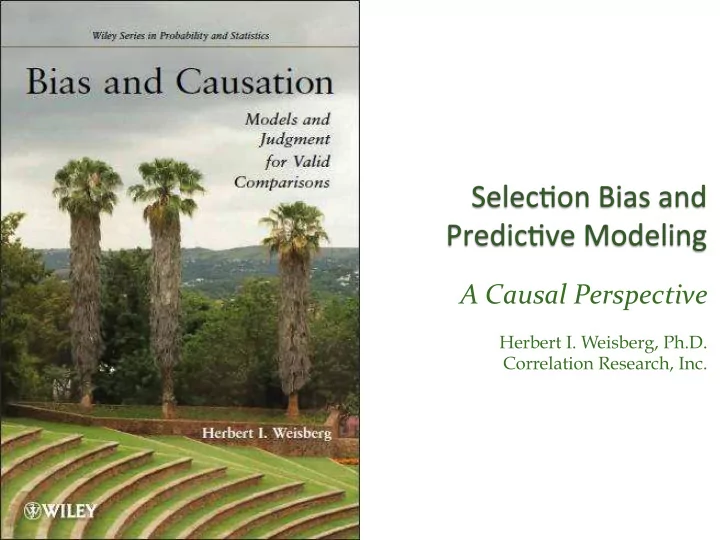

¡ A ¡Causal ¡Perspective ¡ ¡ Herbert I. Weisberg, Ph.D. Correlation Research, Inc.
Typical ¡Insurance ¡Applica0ons ¡ Target: ¡ Action: ¡ Success: ¡ ¡ ¡ ¡ Claims ¡ Investigate ¡ Reduce ¡payment ¡ Applicants ¡ Guidelines ¡ Reject ¡bad ¡risk ¡ Prospects ¡ Solicit ¡ Acquire ¡prospect ¡ Policyholders ¡ Audit ¡ Increase ¡ Policyholders ¡ Service ¡ premium ¡ Prevent ¡attrition ¡
Typical ¡Approach ¡ Measure ¡ outcomes ¡ in ¡a ¡sample ¡of ¡population ¡ 1. 2. Build ¡model ¡to ¡predict ¡outcome ¡ value ¡or ¡ probability ¡ 3. Score ¡ and ¡ rank ¡individuals ¡in ¡sample ¡ 4. Select ¡ cutoff ¡as ¡criterion ¡for ¡ selection ¡ 5. Conduct ¡ ¡RCT ¡to ¡evaluate ¡improvement ¡
Predic0ve ¡Accuracy ¡ Outcome ¡ Good ¡ Bad ¡ Bad ¡ 100 ¡ 400 ¡ 500 ¡ ¡ ¡ ¡ ¡ ¡ ¡ ¡ ¡ ¡Predict ¡ ¡ ¡ Good ¡ 1400 ¡ 600 ¡ 2000 ¡ Sensitivity ¡= ¡400/1000 ¡= ¡.40 ¡ Specificity ¡= ¡1400/1500 ¡= ¡.93 ¡ Positive ¡Predictive ¡Value ¡ ¡(PPV) ¡= ¡400/500 ¡= ¡.80 ¡ Negative ¡Predictive ¡Value ¡(NPV) ¡= ¡1400/2000 ¡= ¡.70 ¡
Causal ¡Effect ¡in ¡Selected ¡Subset ¡ Outcome ¡ Good ¡ ¡Bad ¡ 400 ¡ 100 ¡ T ¡ 500 ¡ Condition: ¡ 100 ¡ 400 ¡ C ¡ 500 ¡ RD ¡= ¡.2 ¡-‑ ¡.8 ¡= ¡-‑.6 ¡
Problem ¡with ¡Usual ¡Approach ¡ Goal: ¡Maximize ¡ ¡improvement ¡ ¡ ¡ ¡ Ideal: ¡Select ¡only ¡those ¡who ¡would ¡change ¡(counterfactual) ¡ ¡ BUT: ¡ Model: ¡Targets ¡those ¡normally ¡ “ Bad ” ¡but ¡not ¡necessarily ¡correctable ¡ Accuracy: ¡Measure ¡(e.g., ¡sensitivity) ¡used ¡is ¡not ¡necessarily ¡ appropriate ¡ THEREFORE: ¡ Selected ¡Subset ¡based ¡on ¡Model ¡may ¡not ¡be ¡optimal ¡(Selection ¡Bias) ¡ Causal ¡effect ¡may ¡improve ¡performance ¡ ¡very ¡little ¡ ¡ ¡ ¡ ¡ ¡ ¡ ¡
Underlying ¡Causal ¡Model ¡ ¡ ¡Normal ¡(Control) ¡ Special ¡Treatment ¡ 1 3 5 5 3 Outcome ¡= ¡Bad ¡ Outcome ¡= ¡Good ¡
Response ¡PaBerns ¡ Treated ¡ “ Control ” ¡ ¡ ¡ ¡ ¡ ¡ ¡Bad ¡ ¡ ¡ ¡ ¡ ¡Bad ¡ Doomed : ¡ ¡ ¡ ¡ ¡ ¡Bad ¡ ¡ ¡ ¡ ¡ ¡Good ¡ Causal : ¡ ¡ ¡ ¡ ¡ ¡Good ¡ ¡ ¡ ¡ ¡ ¡Bad ¡ Preventive : ¡ ¡ ¡ ¡ ¡ ¡Good ¡ ¡ ¡ ¡ ¡ ¡Good ¡ Immune : ¡
Distribu0ons ¡of ¡Response ¡PaBerns ¡ Response ¡Pattern ¡ Selected ¡ Unselected ¡ ¡ ¡ ¡ Doomed ¡ p₁ ¡ q₁ ¡ ¡ ¡ ¡ Causal ¡ p₂ ¡ q₂ ¡ ¡ ¡ ¡ Preventive ¡ p₃ ¡ q₃ ¡ ¡ ¡ ¡ Immune ¡ p₄ ¡ q₄ ¡
Example ¡ Response ¡Pattern: ¡ Selected ¡ Unselected ¡ ¡ ¡ ¡ Doomed ¡ 100 ¡ 200 ¡ ¡ ¡ ¡ Causal ¡ 0 ¡ 0 ¡ ¡ ¡ ¡ Preventive ¡ 300 ¡ 400 ¡ ¡ ¡ ¡ Immune ¡ 100 ¡ 1400 ¡ _____________________ ¡ _______________________________________ ¡ 500 ¡ 2000 ¡ Total ¡
Causal ¡Effect ¡in ¡Selected ¡Subset ¡ Outcome ¡ Good ¡ ¡Bad ¡ 400 ¡ 100 ¡ T ¡ 500 ¡ Condition: ¡ 100 ¡ 400 ¡ C ¡ 500 ¡ RD ¡= ¡.2 ¡-‑ ¡.8 ¡= ¡-‑.6 ¡
Causal ¡Effect ¡in ¡Selected ¡Subset ¡ Outcome ¡ Good ¡ Bad ¡ N T ¡ ¡ (p 3 ¡+ ¡p 4 ) ¡ N T ¡ ¡ (p 1 ¡+ ¡p 2 ) ¡ N T ¡ T ¡ Condition ¡ C ¡ N C ¡ (p 2 ¡+ ¡p 4 ¡) ¡ N C ¡ (p 1 ¡+ ¡p 3 ¡) ¡ N C ¡
Causal ¡Effect ¡in ¡Selected ¡Subset ¡ ( ¡No ¡ “ Causals ” ¡) ¡ Outcome ¡ Good ¡ Bad ¡ N T ¡ ¡ (p 3 ¡+ ¡p 4 ) ¡ N T ¡ p 1 ¡ N T ¡ T ¡ Condition ¡ C ¡ N C ¡ p 4 ¡ ¡ N C ¡ (p 1 ¡+ ¡p 3 ¡) ¡ N C ¡ RD ¡= ¡ ¡ ¡-‑p 3 ¡
Example ¡ Response ¡Pattern: ¡ Selected ¡ Unselected ¡ ¡ ¡ ¡ Doomed ¡ 300 ¡ 200 ¡ ¡ ¡ ¡ Causal ¡ 0 ¡ 0 ¡ ¡ ¡ ¡ Preventive ¡ 100 ¡ 400 ¡ ¡ ¡ ¡ Immune ¡ 100 ¡ 1400 ¡ _____________________ ¡ _______________________________________ ¡ 500 ¡ 2000 ¡ Total ¡
Causal ¡Effect ¡in ¡Selected ¡Subset ¡ Outcome ¡ Good ¡ ¡Bad ¡ 200 ¡ 300 ¡ T ¡ 500 ¡ Condition ¡ 100 ¡ 400 ¡ C ¡ 500 ¡ RD ¡= ¡.6 ¡-‑ ¡.8 ¡= ¡-‑.2 ¡
The ¡CuIng ¡Edge ¡ 1. Attempt ¡to ¡predict ¡ “ success ” ¡not ¡just ¡outcome ¡ ¡ 2. Uplift ¡(a.k.a. ¡Incremental, ¡True ¡Lift, ¡Net) ¡Modeling ¡ ¡ 3. Derive ¡models ¡under ¡Treatment ¡and ¡Control ¡ conditions ¡ ¡ 4. Select ¡targets ¡based ¡on ¡ “ difference ¡score ” ¡ ¡ ¡
Marke0ng ¡Research ¡Terminology ¡ Treated ¡ “ Control ” ¡ ¡ ¡ ¡ ¡ ¡ ¡-‑-‑-‑-‑-‑-‑-‑-‑ ¡ ¡ ¡ ¡ ¡ ¡-‑-‑-‑-‑-‑-‑-‑-‑ ¡ “ Lost ¡Causes ” ¡ ¡ ¡ ¡ ¡ ¡-‑-‑-‑-‑-‑-‑-‑-‑ ¡ ¡ ¡ ¡ ¡ ¡$$$$$ ¡ “ Do ¡Not ¡Disturbs ” ¡ ¡ ¡ ¡ ¡ ¡$$$$$ ¡ ¡ ¡ ¡ ¡ ¡-‑-‑-‑-‑-‑-‑-‑-‑ ¡ “ Persuadables ” ¡ ¡ ¡ ¡ “ Sure ¡Things ” ¡ ¡ ¡$$$$$ ¡ ¡ ¡ ¡ ¡ ¡$$$$$ ¡ ¡ ¡
Caveats ¡ 1. Still ¡have ¡issues ¡of ¡ selection ¡bias ¡ ¡ 2. Each ¡of ¡two ¡models ¡predicts ¡ outcome , ¡not ¡ success ¡ 3. Individual ¡differences ¡are ¡highly ¡ variable ¡ ¡ 4. Some ¡applications ¡in ¡insurance ¡may ¡differ ¡ ¡ ¡
Recommend
More recommend